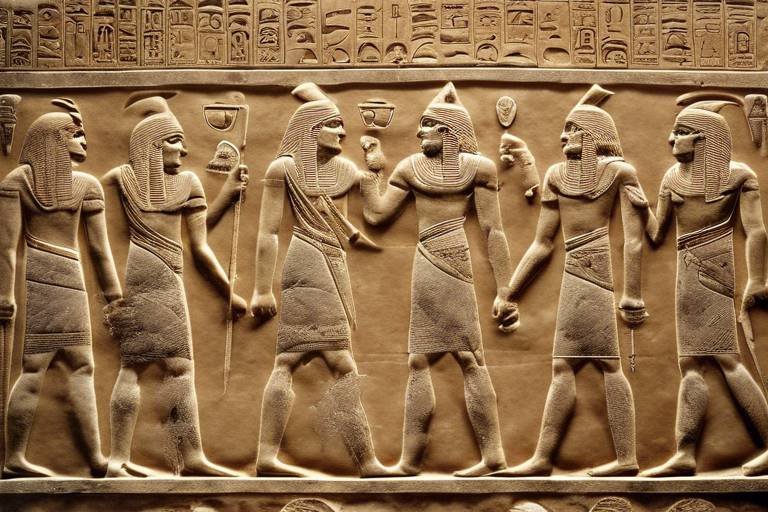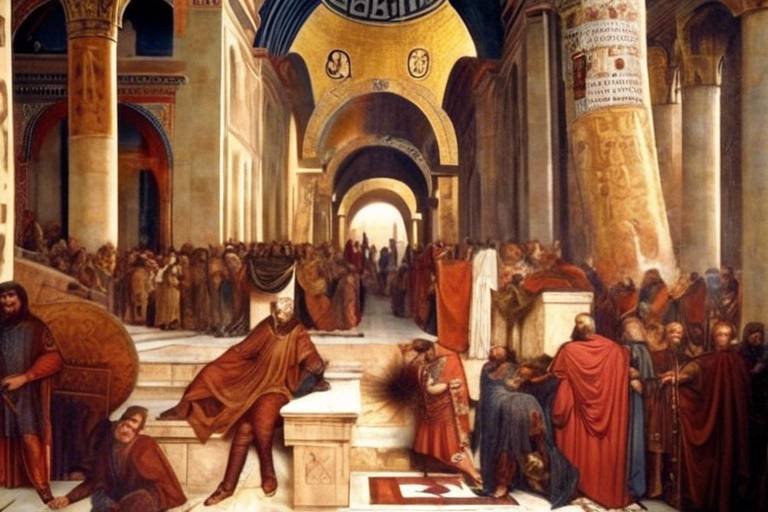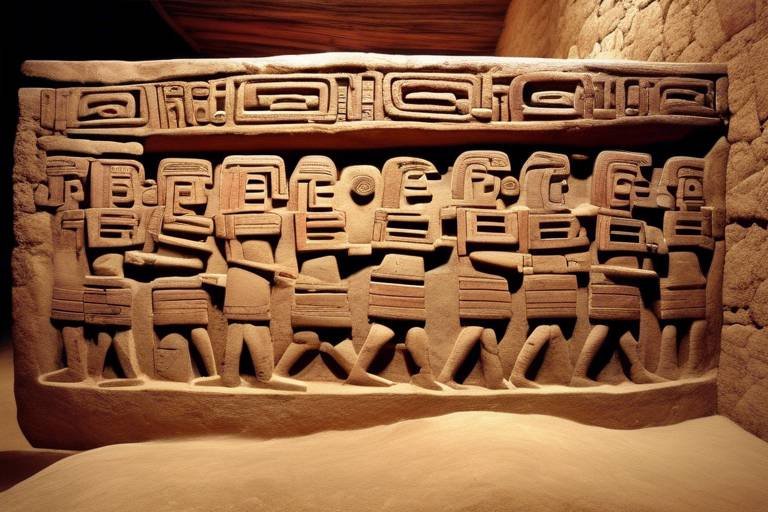The Rise and Fall of the Achaemenid Empire
The Achaemenid Empire, a formidable ancient civilization that once dominated vast territories, has a story filled with grandeur, conquests, and eventual downfall. It all began with the humble origins of the Achaemenid dynasty under Achaemenes, the founder whose vision set the stage for the empire's rise to power. However, it was under the leadership of Cyrus the Great and his successors that the empire truly flourished, expanding its borders and influence across the known world.
As the Achaemenid Empire grew in size and strength, its administration became a marvel of innovation and efficiency. Visionary rulers like Cyrus, Cambyses, and Darius implemented administrative systems that allowed them to govern diverse regions with relative ease. The empire's ability to manage such a vast territory was a testament to its organizational prowess and strategic acumen.
One of the most enduring legacies of the Achaemenid Empire lies in its cultural achievements. From awe-inspiring architecture to intricate artistry, the empire left an indelible mark on history. The establishment of the royal capital at Persepolis stands as a testament to the empire's grandeur and sophistication, showcasing its wealth and power to the world.
However, the path to glory was not without its challenges. The Achaemenid Empire faced numerous conflicts and conquests, including the famous Greco-Persian Wars that pitted them against the mighty Greek city-states. These military campaigns tested the empire's strength and resilience, ultimately shaping its destiny in unforeseen ways.
Despite its remarkable achievements, the Achaemenid Empire began to decline due to internal strife, revolts, and external pressures. The once-mighty empire found itself weakened, making it vulnerable to conquest. The arrival of Alexander the Great marked the final chapter in the empire's history, as his forces swept through Persia and brought an end to the Achaemenid rule.
Nevertheless, the legacy of the Achaemenid Empire endures to this day. Its influence on subsequent civilizations can be seen in governance structures, artistic expressions, and cultural traditions that have persisted through the ages. The empire's impact on shaping the world cannot be understated, making it a pivotal player in the tapestry of human history.
Today, efforts to preserve and study the archaeological remains of the Achaemenid Empire continue, offering insights into its rich history and societal dynamics. These discoveries provide a glimpse into the past, allowing us to appreciate the contributions of this ancient civilization to our collective heritage.
In modern times, the Achaemenid Empire remains a symbol of pride and identity for the Iranian people. Its cultural significance is reflected in various forms of art, literature, and popular culture, keeping its memory alive in the hearts and minds of those who cherish its legacy.

Origins of the Achaemenid Empire
The Achaemenid Empire, one of the most significant ancient civilizations in history, had a journey marked by remarkable achievements, conflicts, and a lasting legacy that continues to influence modern times.
The roots of the Achaemenid Empire trace back to the humble beginnings of the Achaemenid dynasty founded by Achaemenes. However, it was under the leadership of Cyrus the Great and his successors that the empire truly began to flourish. Like a small spark igniting a massive fire, the empire's origins were unassuming but led to an explosion of power and influence across the ancient world.
Through strategic alliances, military prowess, and shrewd diplomacy, Cyrus the Great laid the foundation for the empire's expansion. His successors, including Cambyses and Darius, continued to build upon this legacy, conquering vast territories and establishing a sophisticated administrative system that enabled effective governance over a diverse empire.
Just as a seed grows into a mighty tree, the Achaemenid Empire grew from its modest origins into a dominant force in the ancient world, shaping the course of history through its conquests and cultural achievements.
The rise of the Achaemenid Empire was not merely a series of conquests but a testament to the vision and leadership of its rulers, who navigated complex political landscapes and diverse cultures to create a vast and enduring civilization.

Expansion and Administration
During its reign, the Achaemenid Empire experienced a remarkable period of expansion and implemented innovative administrative systems to govern its vast territories. Under the leadership of influential rulers like Cyrus, Cambyses, and Darius, the empire expanded its borders significantly, incorporating diverse regions and cultures into its domain.
The expansion of the Achaemenid Empire was not merely about conquest but also about efficient administration. The rulers established a system of satrapies, dividing the empire into provinces governed by satraps who collected taxes, maintained order, and ensured loyalty to the central authority. This decentralized administrative structure allowed for effective governance over a vast and diverse empire.
Moreover, the Achaemenid rulers were known for their tolerance towards local customs and religions, which helped in maintaining stability and fostering cooperation among different ethnic groups within the empire. This policy of cultural inclusivity contributed to the longevity of the empire and facilitated the assimilation of diverse populations into the Achaemenid fold.
One of the key administrative innovations of the Achaemenid Empire was the establishment of the Royal Road, a sophisticated network of highways that connected the far-flung corners of the empire, enabling swift communication and efficient transportation of goods and troops. This infrastructure project played a crucial role in the empire's ability to govern effectively and project power across its vast territories.
Furthermore, the Achaemenid rulers were known for their promotion of trade and commerce, which further facilitated the integration of different regions and cultures within the empire. The construction of impressive architectural projects, such as the monumental city of Persepolis, not only served as symbols of Achaemenid power and grandeur but also as centers of administration and cultural exchange.

Cultural Achievements
The of the Achaemenid Empire stand as a testament to the sophistication and creativity of this ancient civilization. One of the most remarkable aspects of their cultural legacy was their architectural prowess, exemplified by the grand structures such as the magnificent city of Persepolis. This architectural marvel, with its intricate carvings, massive columns, and imposing staircases, showcased the empire's wealth and power.
Art flourished under the Achaemenids, with intricate designs adorning everything from pottery to jewelry. Their artistry combined elements from various regions of the empire, creating a unique and diverse aesthetic that reflected the empire's multicultural identity. The Achaemenid Empire's artistry not only served as a form of expression but also as a means of communication, conveying messages of power, wealth, and cultural richness.
Religion played a significant role in Achaemenid culture, with Zoroastrianism emerging as the dominant faith. The empire's rulers promoted religious tolerance, allowing various belief systems to coexist within their vast territories. This inclusive approach to religion fostered a sense of unity among diverse populations and contributed to the empire's stability.
Language was another area where the Achaemenids made significant contributions. Old Persian, Elamite, and Akkadian were used for administrative purposes, showcasing the empire's linguistic diversity. The creation of the Old Persian cuneiform script further solidified the Achaemenid Empire's cultural identity and facilitated communication across its vast domains.
The establishment of Persepolis as the royal capital was a crowning achievement of the Achaemenid Empire. This grand city served as a symbol of imperial power and cultural sophistication, attracting visitors from far and wide. The intricate palaces, audience halls, and ceremonial complexes at Persepolis reflected the empire's grandeur and provided a glimpse into the opulence of Achaemenid society.

Conflicts and Conquests
The Achaemenid Empire, despite its grandeur and vast territories, was not without its share of conflicts and conquests. One of the notable events in its history was the Ionian Revolt, a rebellion by Greek city-states in Asia Minor against Persian rule. This conflict marked the beginning of the Greco-Persian Wars, a series of battles that would shape the course of history.
Under the leadership of Darius the Great, the Achaemenid Empire launched military campaigns to expand its influence further into Europe. The famous Battle of Marathon in 490 BC, where the Persian forces were defeated by the Athenians, was a significant setback for the empire. However, this defeat only fueled Darius' ambition to conquer Greece.
Subsequently, Darius' son, Xerxes I, sought revenge for the Persian defeat at Marathon by launching a massive invasion of Greece in 480 BC. This campaign culminated in the iconic battles of Thermopylae and Salamis, where the Greeks, led by figures like Leonidas of Sparta and Themistocles, managed to repel the Persian forces against overwhelming odds.
Despite these setbacks, the Achaemenid Empire remained a formidable power in the ancient world. However, its dominance was ultimately challenged by the conquests of Alexander the Great. In a series of swift and decisive military campaigns, Alexander managed to defeat the Persian forces in battles such as Issus and Gaugamela, leading to the fall of the Achaemenid Empire in 330 BC.

Decline of the Empire
As the Achaemenid Empire reached its pinnacle of power and influence, internal strife and external pressures began to chip away at its foundations, signaling the start of its decline. The once mighty empire, which had spanned vast territories and diverse cultures, faced mounting challenges that would ultimately lead to its downfall.
One of the key factors contributing to the decline of the Achaemenid Empire was the succession crisis that followed the death of Darius III at the hands of Alexander the Great. This power vacuum created a sense of instability and paved the way for Alexander's conquest of Persia, marking the end of Achaemenid rule.
Furthermore, the empire's vast size and diverse population made it increasingly difficult to maintain control and unity. Revolts and uprisings in various regions, coupled with administrative inefficiencies and corruption, weakened the empire from within, making it vulnerable to external threats.
The relentless expansion of Alexander the Great and his military prowess posed a formidable challenge to the Achaemenid Empire. The swift and decisive conquests by Alexander's forces shattered the once-mighty empire, bringing an end to centuries of Achaemenid rule and ushering in a new era of Hellenistic dominance in the region.
Despite its decline and eventual conquest, the legacy of the Achaemenid Empire endured through its cultural contributions, administrative innovations, and lasting impact on subsequent civilizations. The empire's downfall marked a significant turning point in ancient history, shaping the course of future empires and influencing the development of art, architecture, and governance in the centuries that followed.

Legacy of the Achaemenid Empire
The legacy of the Achaemenid Empire is a tapestry woven with threads of influence that have endured through the annals of history. This ancient civilization, with its vast territorial reach and cultural richness, left an indelible mark on the world that reverberates to this day. One of the most significant legacies of the Achaemenid Empire is its impact on governance and administrative systems. The concept of satrapies, or provinces, governed by satraps appointed by the central authority, served as a model for future empires and states, shaping the course of political organization for centuries to come.
Furthermore, the Achaemenid Empire's architectural achievements, particularly exemplified by the grandeur of Persepolis, continue to inspire awe and admiration. The intricate carvings, majestic columns, and imposing structures stand as a testament to the empire's architectural prowess and artistic sophistication. These architectural marvels not only showcase the empire's wealth and power but also reflect the cultural fusion and artistic ingenuity that characterized Achaemenid society.
In addition to governance and architecture, the Achaemenid Empire's cultural legacy extends to its contributions in art, language, and religion. The empire's diverse cultural tapestry, influenced by the amalgamation of various ethnicities and traditions within its borders, gave rise to a vibrant artistic scene characterized by intricate metalwork, vibrant textiles, and exquisite pottery. The Achaemenid script, known as Old Persian cuneiform, played a crucial role in disseminating administrative and religious texts, leaving a linguistic legacy that influenced subsequent writing systems in the region.
Moreover, the religious tolerance promoted by the Achaemenid rulers, exemplified by the policy of allowing subject peoples to practice their own faiths, set a precedent for multicultural coexistence that resonates in contemporary discussions on religious freedom and diversity. This ethos of inclusivity and respect for diverse beliefs contributed to the empire's stability and longevity, fostering a sense of unity among its subjects despite their varied backgrounds.
As we reflect on the legacy of the Achaemenid Empire, we are reminded of its enduring influence on the development of civilization and the interconnectedness of human history. From the corridors of power in Persepolis to the echoes of ancient languages in archaeological discoveries, the legacy of the Achaemenid Empire continues to captivate scholars, enthusiasts, and curious minds alike, inviting us to delve deeper into the rich tapestry of the past and draw inspiration for the future.

Heritage and Archaeological Discoveries
The heritage of the Achaemenid Empire is a treasure trove of archaeological discoveries that continue to captivate historians and archaeologists alike. Unearthing the remnants of this ancient civilization provides invaluable insights into its society, culture, and technological advancements. The meticulous study of artifacts, inscriptions, and architectural remains offers a glimpse into the grandeur and sophistication of the Achaemenid Empire.
Archaeological excavations have revealed magnificent palaces, intricate reliefs, and monumental structures that showcase the artistic and architectural prowess of the Achaemenids. The grandeur of Persepolis, the opulence of Susa, and the engineering marvels of Pasargadae stand as testaments to the empire's architectural achievements. These sites not only serve as historical landmarks but also as windows into the past, allowing us to piece together the puzzle of Achaemenid civilization.
Moreover, the discovery of ancient artifacts such as pottery, jewelry, coins, and weaponry provides valuable insights into the daily lives, trade practices, and technological advancements of the Achaemenid people. These artifacts serve as tangible links to the past, offering a tangible connection to a bygone era rich in cultural diversity and artistic expression.
Through the preservation and study of these archaeological discoveries, researchers continue to unravel the mysteries of the Achaemenid Empire, shedding light on its governance structure, societal norms, and religious practices. The meticulous excavation and analysis of sites across the former empire's vast territories contribute to our understanding of ancient Persian civilization and its enduring legacy.

Modern Perceptions and Cultural Significance
Topics to be discussed in the article include the origins, expansion, administration, cultural achievements, conflicts, decline, and legacy of the Achaemenid Empire, one of the most significant ancient civilizations in history.
When we look at the modern perceptions of the Achaemenid Empire, it's fascinating to see how this ancient civilization continues to captivate the imagination of people around the world. The legacy of the Achaemenid Empire is not confined to history books but has transcended time to influence various aspects of contemporary culture. From movies and literature to art and architecture, the Achaemenid Empire's cultural significance endures.
One of the most intriguing aspects of modern perceptions is how the Achaemenid Empire is portrayed in popular culture. Films like "300" and "Alexander" have brought the epic battles and grandeur of the empire to the big screen, sparking interest and curiosity among audiences. These cinematic representations, while often dramatized, play a crucial role in keeping the legacy of the Achaemenid Empire alive in the minds of people today.
Moreover, the cultural significance of the Achaemenid Empire can be seen in the enduring influence it has on Iranian identity and heritage. The achievements of ancient Persian civilization, including its art, architecture, and governance, continue to shape the cultural landscape of modern Iran. The legacy of the Achaemenid Empire serves as a source of pride and inspiration for Iranians, connecting them to their rich historical roots.
As we navigate the complexities of the modern world, the Achaemenid Empire stands as a reminder of the enduring power of ancient civilizations to shape our present and future. By understanding and appreciating the cultural significance of this remarkable empire, we not only honor the past but also gain valuable insights into the complexities of human history and heritage.
Frequently Asked Questions
- What were the major cultural achievements of the Achaemenid Empire?
The Achaemenid Empire made significant cultural contributions, including advancements in architecture, art, religion, and language. One of the most notable achievements was the construction of the royal capital at Persepolis, showcasing intricate artwork and architectural marvels.
- How did the Achaemenid Empire handle its vast territorial expansion?
The empire managed its expansive territories through innovative administrative systems, such as the division of the empire into satrapies governed by satraps. This decentralized governance structure allowed for efficient control over diverse regions and facilitated the collection of tribute and taxes.
- What led to the decline of the Achaemenid Empire?
The decline of the empire was influenced by internal strife, revolts within the satrapies, and external pressures from invading forces. Economic challenges, succession disputes, and the inability to quell rebellions all contributed to the gradual weakening of the Achaemenid Empire.
- How has the legacy of the Achaemenid Empire influenced modern perceptions?
The legacy of the Achaemenid Empire continues to impact modern times through its representation in popular culture, historical studies, and the preservation of archaeological sites. Its enduring influence on Iranian identity, governance structures, and artistic traditions is a testament to its lasting significance.



















